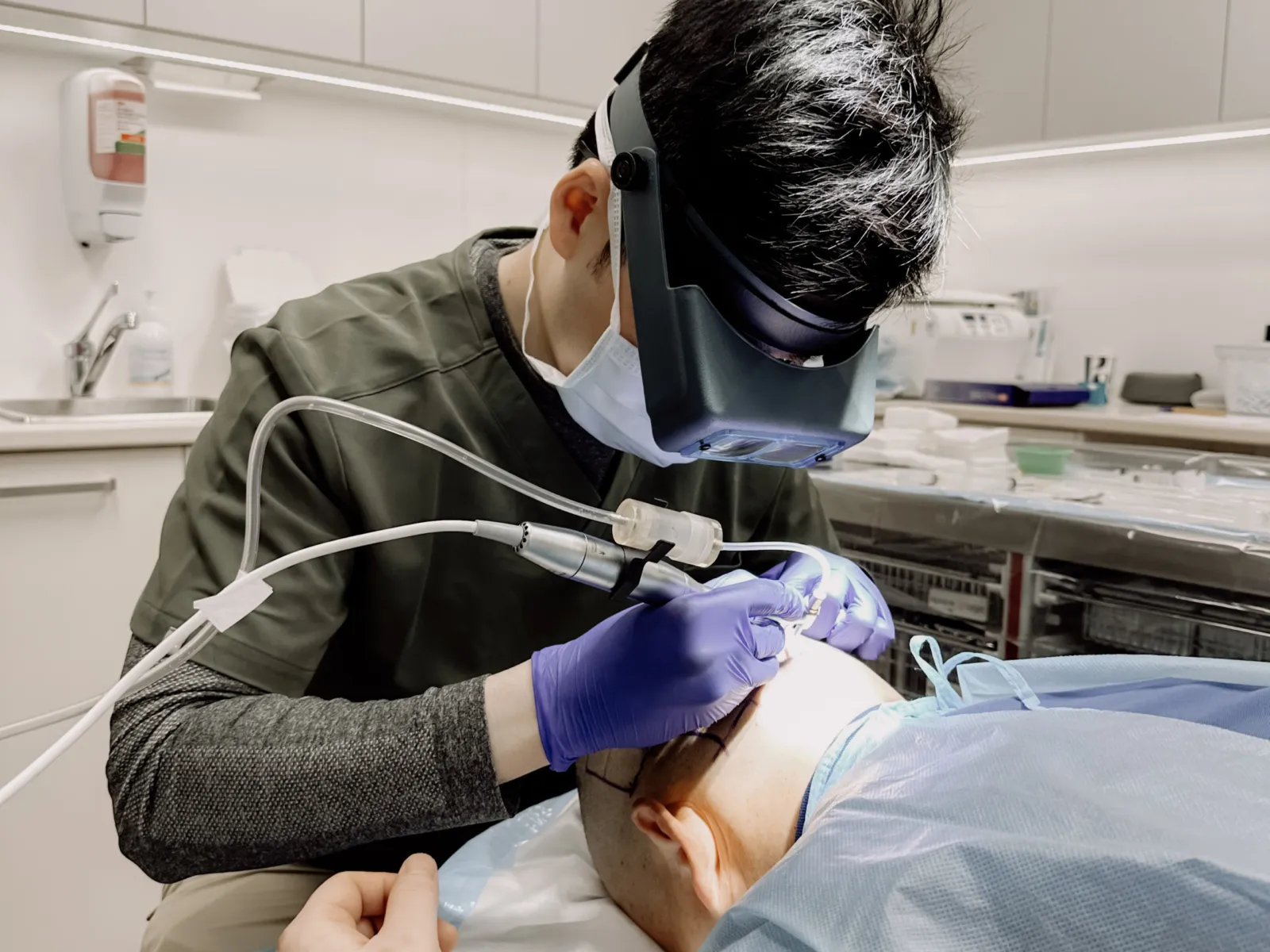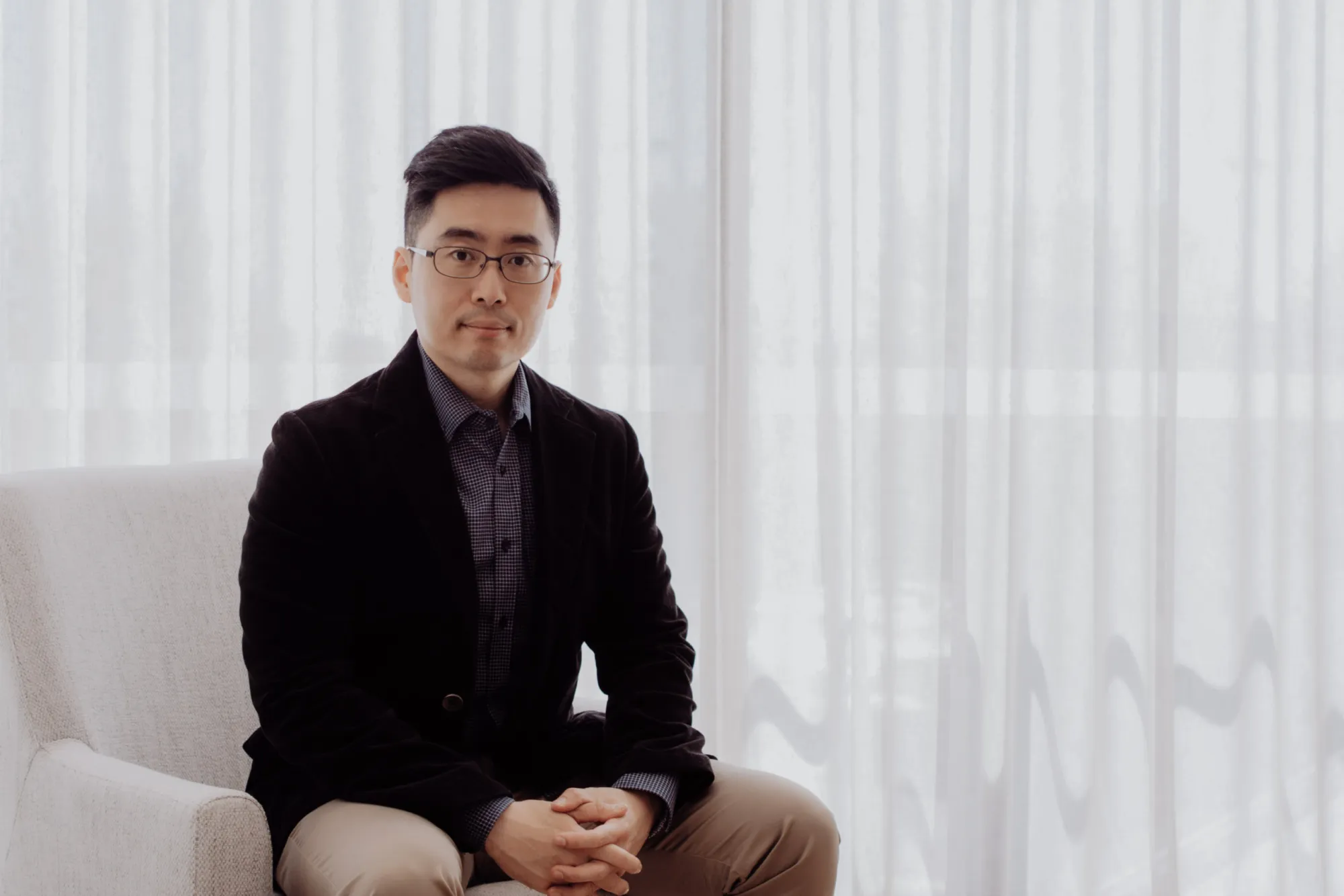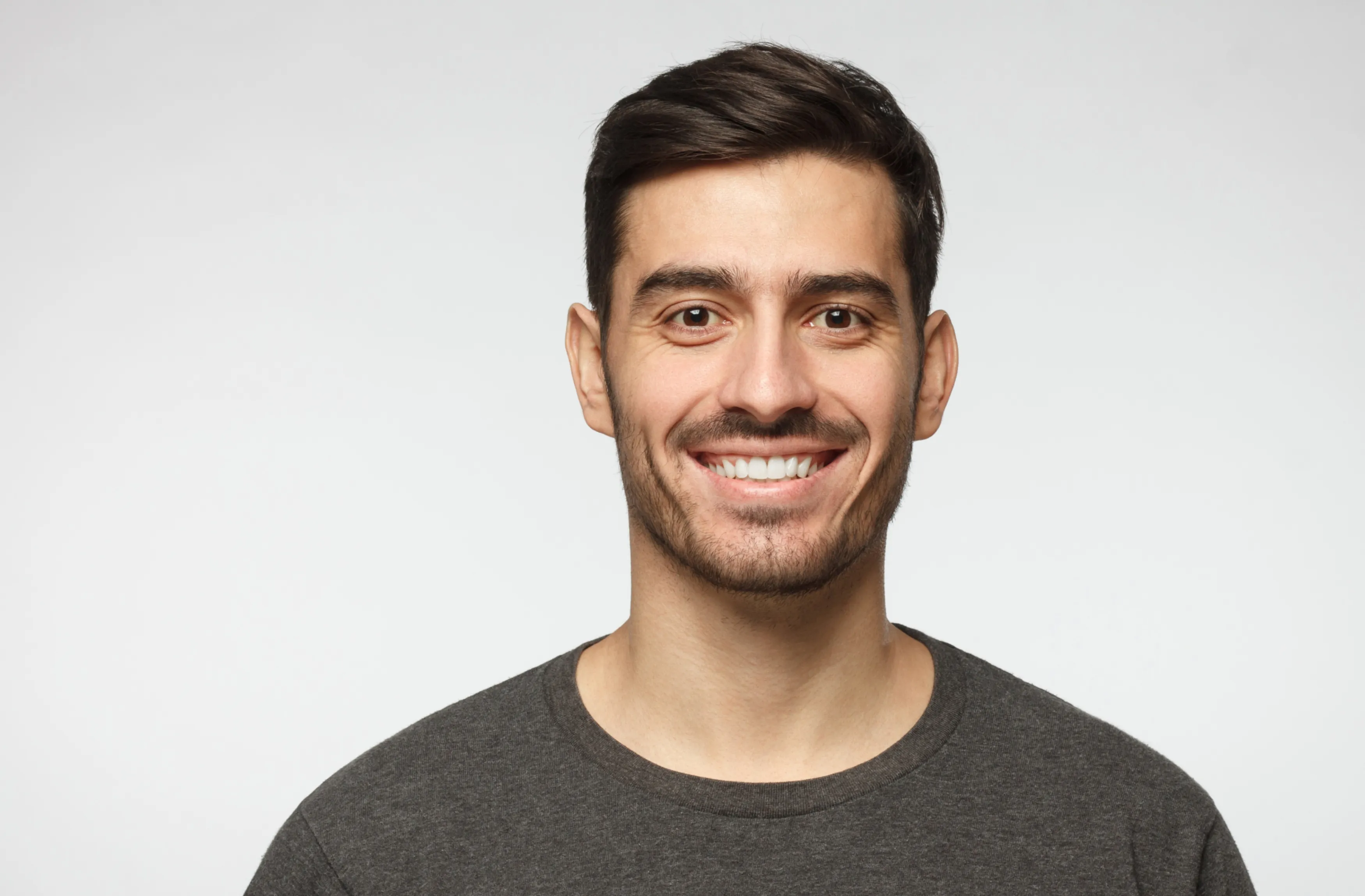The Hair institute by The R Clinic
The Hair institute by The R Clinic
Canberra’s first and finest hair transplant clinic
Hair Regrowth with passion. We are the leading hair loss clinic in Canberra. We love what we do, and it shows.
Whether you want to stop hair loss, regrow your hair or maintain strong hair growth, we have the right solution for you.
Conditions
Treatments
Men’s Hair Loss
Men’s Hair Loss
Male pattern baldness, also known as androgenic alopecia, affects over half of all men aged over 50. It is one of the most common reasons why people choose to have a hair transplant.
Male pattern baldness is an inherited trait that can give men a thinning crown and receding hairline. The cause of male pattern baldness is dihydrotestosterone (DHT), a by-product of testosterone. DHT can affect sensitive hair follicles by shrinking them over time. In the process of the affected hair follicles getting smaller, the life span of the hair is reduced. This continues until the affected follicles cease to produce hair.
Women’s Hair Loss
Women’s Hair Loss
Female hair loss is extremely common, particularly after pregnancy and menopause. In fact, it can affect as many as one in three women. There are many causes of female hair loss such as hormonal imbalance, medication, stressors, lifestyle factors or other medical conditions, so establishing the correct diagnosis at an early stage is very important for treatment. As with male hair loss, androgenic alopecia is the most common cause of hair loss in women.
Alopecia Areata (Patchy Hair Loss)
Alopecia Areata (Patchy Hair Loss)
Alopecia areata is a skin condition that causes a sudden loss of patches of hair on the scalp and sometimes other parts of the body. The typical hair loss pattern for alopecia areata is to have one or more bald areas on the scalp or facial hair that are round and the size of a large coin. In alopecia areata, the body’s immune system mistakenly attacks the hair follicles for reasons that are not clear. Fortunately, the follicles retain their ability to regrow hair, and the hair loss is not permanent in most cases. It can begin at any age; however, most people develop it during childhood or their teenage years.
Excessive Shedding (Telogen Effluvium)
Excessive Shedding (Telogen Effluvium)
Telogen effluvium is a form of hair loss. It is commonly associated with hair loss in women, but the diagnosis can affect males too. Most people lose up to 100 hairs a day, but someone with telogen effluvium may lose up to 300 hairs. This is because more hair follicles than average move into the resting and shedding phase. You will notice less hair volume as a result of more hair being shed than is actually grown.
In around 30% of people with telogen effluvium, doctors cannot find a cause. However, many different triggers have been identified such as going through a severe illness, psychological stress, drastic diet changes, medication.
FUE Transplantation
FUE Transplantation
To ensure full hair regrowth and replenishment, hair transplants can be the most effective treatment option for hair loss. They are a great permanent solution to hair loss as they can restore the hair, offering people a more youthful appearance, but should only be considered when the underlying cause for hair loss has been stabilised.
Growth Factor Therapy
Growth Factor Therapy
Growth Factor Therapy, has been scientifically proven to improve the growth phase of the hair cycles, improve scalp health and increase hair density and thickness. Platelets release growth factors within the scalp and hair follicles to stabilise hair loss, improve blood supply and nutrients to the area, rejuvenate dormant hair follicles, leading to an overall increase in hair number and reduced shedding.
Medication
Medication
Two active ingredients exist that have been proven to stop hair loss. We can’t name them here for legal reasons, but here’s a quick rundown.
Medication A: this treatment increases blood flow to the scalp, thickening the individual hairs and lengthening the time they spend in their growth phase.
Medication B: this treatment blocks the enzyme that converts testosterone to dihydrotestosterone (DHT). DHT is the hormone that wreaks havoc on your hair follicles, so the treatment prevents and even reverses hair loss by lowering the amount of DHT arriving at the scalp.
Light therapy (Low Level light therapy)
Light therapy (Low Level light therapy)
Laser therapy for hair loss, or Low-Level Light Therapy (LLLT), is a proven treatment that helps hair follicles regrow hair. It is commonly used to treat genetic forms of hair loss common in men and women. The laser light that’s used in LLLT produces a particular wavelength, which has a unique ability to be absorbed by the molecules of the hair follicles. The light helps to shift hair follicles into the growth stage in multiple ways.
Why Us
At The Hair Institute, we understand that hair loss can be distressing and can psychologically impact many aspects of your life.
We offer our patients the most advanced technology in hair regrowth with a particular expertise in minimally invasive transplant techniques which are 100% tailored to your hair loss condition. Our state-of-the-art treatments don’t require a hospital stay, have a shorter downtime compared with other transplant methods, and can take place right here in our fully equipped and comfortable Canberra clinic.
Accompanied with a wealth of knowledge in hair regrowth, our professional team can help you achieve your hair growth goals.
Comprehensive Doctor-led Service
Comprehensive Doctor-led Service
Even if you are just seeking for non-surgical treatment to restore your hair, our hair doctor can also provide you medical treatment, such as prescription medication, growth factor therapy, light therapy, scalp mesotherapy to help you optimise your scalp condition and giving you the best chance for hair regrowth.
Expert in Follicular Unit Extraction (FUE)
Expert in Follicular Unit Extraction (FUE)
At The Hair Institute, our team has fine-tuned the hair transplant process to yield consistently outstanding result for our client. Everything from age-appropriate hairline design, follicular unit extraction using microsurgery, graft preparation and sorting, recipient site creation with consideration to hair depth, angulation, and direction, to high density graft implantation to give your implanted hair best chance of survival.
Innovative Technology with NeoGraft®
Innovative Technology with NeoGraft®
NeoGraft® is the latest revolutionary automated Follicular Unit Extraction (FUE) technology leaves no linear scar and is minimally invasive with fast patient recovery. It eliminates the inefficiencies of common manual tools and procedures while enabling physicians to offer hair transplants with consistent clinical outcomes.

How NeoGraft® Works
Meet Dr Wen

Dr Wen Shan-Sung (Dr Wen) is the Medical Director of THE R CLINIC with more than 10 years of extensive experience. Dr Wen is the founder of Canberra’s first hair transplant centre The Hair Institute specialising in follicular unit extraction (FUE).
Having suffered from a hair loss condition (alopecia) himself, Dr Wen is passionate about helping patients within Canberra and the surrounding communities with the most advanced and innovative technologies in FUE Hair transplant techniques. Dr Wen dedicates his time to mastering his craft and with a healthy obsession for technical excellence, Dr Wen frequently attends national and international conferences to learn from the world’s leading experts, and to further immerse himself in the latest research and technology.
In addition to providing state of the art hair loss treatments, Dr Wen is a skilled cosmetic physician with advanced training in all areas of injectable cosmetic medicine. Dr Wen’s areas of interest and expertise include bespoke skin rejuvenation with medical-grade cosmeceuticals and non-surgical facelifts with advanced thread lifting methods. Using advanced technology and treatment techniques, Dr Wen strives to achieve the best outcomes both medically and aesthetically for his patients. Dr Wen is changing the way we think about cosmetic medicine, empowering his patients to celebrate their unique individuality to be the best version of themselves.
Outside work, Dr Wen indulges his love of adventure. In summer he’s a kitesurfing enthusiast who loves riding the big waves. In winter, he’s a snowboarding junkie – his ambition is to be able to do a 180 backflip the next time he hits the slopes.
Qualifications & Affiliations
- Fellow of Australasian College of Cosmetic Surgery and Medicine (FACCSM)
- Member of The International Society of Hair Restoration Surgery (ISHRS)
- Fellow of The Royal Australian College of General Practitioners (FRACGP)
- Bachelor of Medicine, Bachelor of Surgery (MBBS, University of Tasmania)
- Bachelor of Medical Science (BMedSc, University of Tasmania)
- Member of American Society for Laser Medicine & Surgery
Areas of Speciality
- Minimally Invasive Hair Transplantation with FUE (Follicular Unit Extraction)
- Laser & Energy-Based Dermatology Treatments for skin rejuvenation and aesthetic concerns
- Non-Surgical Face & Body Contouring with FaceTite and Quantum RF (INMODE RF technology)
- Pan-Facial Rejuvenation using a multi-layered approach
Delivering Real Results
Comprehensive Guide to Hair Loss Treatment
Want to know more about the conditions we treat and more about our advanced hair-loss procedures?
Download our Comprehensive Guide to Hair Loss Treatment.
FAQs
Have further questions or want to learn more?
Am I a candidate for the FUE hair transplant?
Hair transplant procedures using FUE technique may be suited for all hair types for both men and women. While most people can get the procedure, there are key factors that will determine if you’re the ideal candidate, that is, degree of hair loss, number of grafts necessary to produce the desired results, density, and quality of the donor hair, hair texture, and potential for future hair loss. Our experience physician will advise you on your eligibility and other possible options.
Do hair transplants hurt?
Some people might have the belief that the procedure is very painful. However, many of those who have a hair transplant doesn’t feel anything during the procedure itself. After a local anaesthetic has been administered via an injection into the target area of the scalp, a patient should not feel any discomfort.
We can also provide pain-relieving medications to help reduce discomfort further. Many measures are used to increase the comfort level of patients during the procedure. You may like to watch movies on your tablet or listen to music, to help keep your mind off the procedure. All of this is offered at The Hair Institute, our custom-built hair transplant treatment room is temperature-controlled, and we offer aromatherapy to help relax your body and mind.
How long does a hair transplant last?
The results of a hair transplant, which can usually be seen after a year, can last many people for life. Certainly, you can expect results to last for 15-20 years or more. The potential permanence of a hair transplant is one of the reasons it is so important to be happy with the results.
If you are taking medications to prevent further hair loss, the results of your hair transplant are set to suit you for a longer time. If you do not take medications to prevent further hair loss, there is the chance that your hair transplant results will no longer suit you after further hair loss has occurred. For these cases in which hair has receded behind the implanted hairs, a second or third hair transplant are options.
How long is FUE hair transplant?
Duration of your procedure depends on the number of grafts. Extraction and implantation of the average number of 2000 grafts can take 6-8 hours. You can read a book or watch movies on a tablet while comfortably seated or propped up during the procedure.
How much dose a hair transplant cost?
The procedure cost depends on the number of grafts you would need to address your specific hair loss concern and your type of hair the cost per graft. The average number of grafts required per procedure is ~ 2000. The estimated cost per graft is between $7-10.
How soon will I see result?
In the first 1-3 months following hair transplant, the newly transplanted hairs usually become dormant and will shed before growing again in 4-12 months. It may take 9-12 months before the full result will be realised.
So what hairline should I go for?
Seeing our hair transplant surgeon is the first step to answering this question. At The Hair Institute our surgeons make sure to take you through all the considerations you need to make before deciding on a hair transplant. We prefer to plan a hairline that is mature which will suit you for the rest of your life.
A lot of patients request for their hairline to be brought down to match the hairline they had when they were in their teens. It is our opinion that this is not a good idea. Not only will this require many hair grafts that thin your donor zone but also your ongoing balding process will mean a hairline that is too low will look odd. As you age, your temples will recede and a hairline that is low will look like a strip of hair separated from the hair behind it. It will look unnatural and it won’t suit you in your middle- late age.
What if I’m not ready for a hair transplant?
It’s common for men experiencing hair loss to consider alternative treatment options before ultimately deciding on a hair transplant. Usually, the first step is to begin taking hair loss medications, which can help slow down the hair loss process. Here at The Hair Institute, we also provide comprehensive medical therapies to suit individual’s need.
When should I have FUE hair transplant surgery?
Hair transplants are not a treatment for those early in their hair loss journey (e.g. age <27 years). This is because the processes driving hair loss (the hormone DHT) are still very active and can cause you to bald further. We encourage our younger adults to wait or commence medical treatments to prevent the production of DHT, and stabilise their hair loss before deciding to undergo hair transplant surgery.
Will I need a second hair transplant later?
If you have a personal history of hair loss that is not stabilised on hair loss medications then it is likely that you will require a second hair transplant. It is important to consider a holistic medical approach to hair loss and not just surgery when it comes to managing balding or thinning.
If you have stabilised your hair loss then it is unlikely you will require a second hair transplant.
Will my hair transplant look natural?
Definitely! One of the key benefits of FUE technique is that donor hairs are harvested in what are called “follicular units”. These are the units that hair naturally grows in, and therefore, once they are transplanted, they will look totally natural.
Have questions or need guidance?
Share your details and receive a call from our expert medical team at a time that is convenient to you.
- Call
- 02 5119 3898
- contact@rclinic.com.au
Request a callback
"*" indicates required fields
